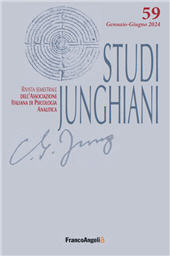Imaginatio alchemica e nessi acausali versus terzo analitico intersoggettivo nella spiegazione dei fenomeni sincronici
47-58 p.
Jung distingue due forme di pensiero, logico-discorsivo e per immagini, che sono alla base della relazione tra inconscio e coscienza. Il lavoro con le immagini assume una crescente importanza nella sua teoria in seguito agli studi sull'alchimia. Questi ultimi, assieme alle teorie della meccanica quantistica, lo conducono a una visione unitaria del mondo in cui non vigono le leggi dello spazio-tempo e della causalità, ma l'unità tra spirito e materia dell'unus mundus, in base alla quale egli interpreta i fenomeni di sincronicità.
Per altre teorie è l'identificazione proiettiva che determina le interazioni circolari presenti nelle diadi madre-bambino e analista-paziente, ed è all'origine della capacità di pensare e della costituzione dell'area transizionale e del terzo analitico intersoggettivo. Quindi la spiegazione dei fenomeni di sincronicità attraverso l'ipotesi dei nessi acausali si deve confrontare con il paradigma dell'intersoggettività. [Testo dell'editore].
Jung distinguishes two forms of thought, logical-discursive and through images, which underlie the relationship between the unconscious and consciousness. The work with images assumes a growing importance in his thinking, following his studies on alchemy. These ones combined with the studies on quantum mechanics bring about a unified vision of the world in which the laws of space-time and causality do not apply, but the unity between spirit and matter of the unus mundus. On this basis he interprets the phenomena of synchronicity. In other theoretical systems, projective identification determines the circular interactions present in the mother-child and analyst patient dyads and is at the origin of the development of thought and of the constitution of the transitional area and of the intersubjective analytic third. Therefore, the explanation of synchronicity phenomena through the hypothesis of acausal links must be compared with the paradigm of intersubjectivity. [Publisher's Text].
Fait partie de
Studi junghiani : rivista semestrale dell'Associazione italiana di Psicologia Analitica : 59, 1, 2024-
Articles du même numéro (disponibles individuellement)
-
Informations
Code DOI : 10.3280/jun59-2024oa18133
ISSN: 1971-8411
KEYWORDS
- imaginatio, unus mundus, identificazione proiettiva, funzione alfa, fenomeni transizionali, terzo analitico intersoggettivo
- imaginatio, unus mundus, projective identification, alpha function, transitional phaenomena, intersubjective analytical third


